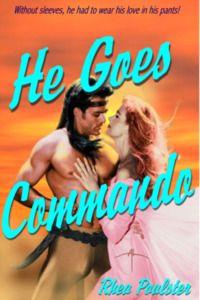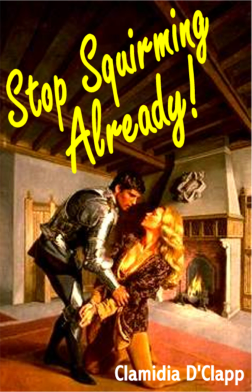Romance novel
The Romance novel is the highest form of literary masterworks that fiction has ever known. It at once probes the dewy moistness of plot, while it throbs with purpose, knowing no bounds in which its authors will stop to please and sate their gentle reader, all for the affordable price of just $3.95 at better drug and discount stores near you.
Classical Origins
Geoffrey Chaucer is credited with writing the first “modern” romance story, The Tale of the Tempestuous Whetnurse, in 1395. While cautionary tales of women left alone during the crusades were commonplace, Chaucer’s work elevated the deep well of loneliness to new depths, touching many women’s hearts while setting their loins aflame.
- Adelbert pluck'd his lute, from which a song pronounced itself in a way that toucheth the heart of faire Elizabeth. From her eye sprang forth a tear, and from her lips the murmur of her lover's name “Mergatroid, cometh soon for I fear the garment is about to rust and thine belt contains the only key."
Deemed “Lewd and without decency as to rile the pubic” by Queen Elizabeth the romance novel disappeared from popular culture until it was resurrected in the early 19th Century by Jane Austen whose flowing prose set forth the trembling fingers of nubile trepidation as those women who could read, and were brave enough to lightly finger the pages holding forth the gentle love that few had known before, dared to delve deeper into the plotlines that inflamed and soothed their weary souls.
Of course the Japanese and Chinese were very adroit and cunning creatures with tales of romance and domination, combined with perverse pleasures that would shock those who were members of gentile society. So we won’t delve into such perversions here, as we are adults, not nymphomaniacs or satyrs loose in a cruel society ripe with white slavery and opium dens of evil.
Current examples
Today the modern romance novel is apt to provide a furtive glance into the lives of those people that we wish we were, and know that we will never be. Yes, the characters live exciting lives, but there is a price to pay. Heartbreak – the sweet ecstasy of denial and knowing that they have done the right thing is almost certain.
The following excerpt is from the novel A Roma, con amore!, written in 1899 by Alain Rouveret.
- Amélie tried to avert her eyes, as Martin shed all of his declensions. But she could not help it but to stare as this splendid vulgar Latin shed his cases. The nominative, accusative, and ablative cases were tossed upon the floor with an insouciance. With egality, fraternity, and liberty, Martin discarded the last of his genetive and dative cases.
- Amélie sighed with heavy breath. Her muscles tightened in conditional tense. The sights and smells were so plusquamperfect! Her legs formed a silken intertwining with Martin’s, as they began conjugation in all of its forms—plural and singular. Martin began to pulse with great inflection.
- “I desire nothing but to create copulae with you,” whispered Martin. “Sto vivendo un sogno. State vivendo un sogno. Sta vivendo un sogno.
- Martin brought his arms together. Amélie nestled within his verb-frame. She reached out and grabbed some Oïl, and spread it upon Martin’s Gallo-Romance branch. Martin’s dangling vowels dropped as Amélie pluralized.
- “This is the perfect Piemontese moment. I wish this Latin Union could last forever,” thought Amélie, as she heaved a “um, dois, trôs” to herself. “I am no longer a mere Provençal girl. This Gascon has made me a complete woman.” Amélie admired Martin’s body. Beneath the golden glow of sunlight streaming, the two formed a dialect continuum. The passion was mutually intelligible and full of euphony.
- “Je t’aime,” murmured Martin.
- “Yo quiero, Taco Bell” whispered Amélie.
- The goat slumbered.
Plot
An appropriate plot for the Romance Novel is bereft of all characterization, sense, and literary devices generally considered mandatory for a good novel. Like the short story (to which it is often compared), the romance novel does not bother itself with messy things such as recapitulation, foreshadowing, rising action, or climax (in the case of the latter two terms, we refer to the literary devices). Instead, it relies solely on "hot and heavy" tales of rising, climax, danger, intrigue, and melodrama. Generally, the plot will follow a young heroine on a search for love. The hapless reader will find themselves feeling sorrier and sorrier for the young innocent as she goes about her life oh-so-alone, searching for the right man for her.
Marketing efforts
The essential purpose of the Romance Novel is to appeal to as wide an audience as possible while still managing to feel intimate to the oppressed housewife to whom it is sold. To do this, oftentimes a publicist will employ some crafty yet ultimately unoriginal methods to appeal to the inner *sigh* within all of us.
- Cover Art - The first thing a person will see when considering the purchase of a Romance Novel, and therefore the most important. A good cover must be able to instantly quell the buyer's instinctive urge to ponder "Do I really need to read another one of these books?" Thus, a simplistic design wherein a voluptuous, small, and vulnerable female is held by a steroid-abusing muscleman with far too much testosterone, both bathed in golden light, is popular. The choice of a sufficiently attractive redhead female is likely to skyrocket the sales among the male sector, while the choice of a muscular enough man is likely to do the same in the gay male sector. For females, however, the quandary of whether or not to buy the book remains, and thus the next device is employed.
- Plot Summary - Also known as "the back of the book", a good plot summary is imperative to get someone to purchase the novel. A well-written summary, usually using overly flowery vocabulary while actually disclosing none of book's flimsy storyline, often goes something like this: "In 'Jack and Jill Went Up the Hill', Nora Smith weaves a heartrending and utterly uplifting tale in which her brilliantly imagined heroine Stephanie attempts to navigate her way through the marshlands of her heart while doing so in a thankless home in the Everglades. Join Stephanie as she embarks on an adventure of self-fulfillment, friendship, heartbreak, and, ultimately, love." In this, the uncertain reader is likely hooked, blind to the fact that he/she has read similar summaries many times before. By touching that little part inside the reader that says "My life fucking sucks", it has managed to make the novel a personal reflection of their own lives.
- Title - The title is almost immaterial if the previous devices are correctly followed. However, for the sake of completeness, a good title is usually either a metaphor for sex (ie: "The Happy Times I Had With Bees", calling to mind the popular phrase "the birds and the bees"), an obtuse and deep-sounding yet utterly nonsensical mashup of words (such as the bestseller "Twelve Strokes to Yesterday"), or simply the main character's name ("Ezekiel" being the most popular example). A catchy title is often chosen to help cause buzz, and to have more people read the book, but is, again, almost extraneous.
See also


